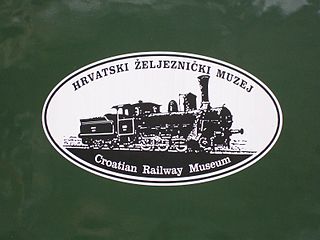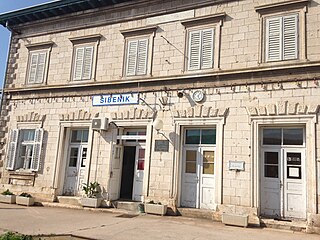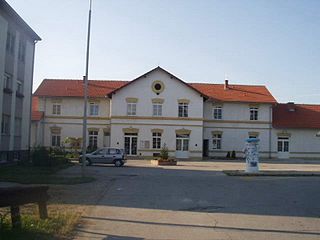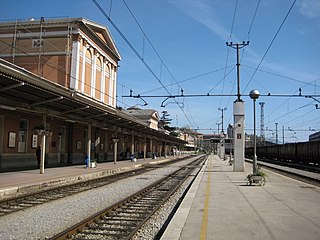
Bosnia and Herzegovina has facilities for road, rail and air transport. There are five international road routes and 20 state highways, with bus connections to many countries. Railways total just over 1,000 km with links to Croatia and Serbia. There are 25 airports, seven of them with paved runways. The Sava River is navigable, but its use is limited.

Vinkovci is a city in Slavonia, in the Vukovar-Syrmia County in eastern Croatia. The city's registered population was 28,247 in the 2021 census, the total population of the city was 31,057, making it the largest town of the county. Surrounded by many large villages, it is a local transport hub, particularly because of its railways.

Slavonski Brod, commonly shortened to simply Brod, is a city in eastern Croatia, near the border with Bosnia and Herzegovina. Being one of the principal cities in the historical regions of Slavonia and Posavina, Slavonski Brod is the 7th largest city in the country, with a population of 59,141 at the 2011 census. It is the centre of Brod-Posavina County and a major river port on the Sava river.

Solin is a town and a suburb of Split, in Split-Dalmatia county, Croatia. It is situated right northeast of Split, on the Adriatic Sea and the river Jadro.

Črnomerec is one of the city districts of Zagreb, Croatia. It is located in the western part of the city and has nearly forty thousand inhabitants.

The Split Metro is a suburban railway network in Split, Croatia. The railway was opened on refurbished existing M604 tracks on December 10, 2006. It consists of one line serving seven stations, running from Split centre to Kaštel Stari. The second line between Split centre and Split-Kopilica opened in June 2019, and was discontinued in November 2019. As of 2019, it is planned that new stations will be added along the tracks and the existing stops renovated. The line runs through two tunnels within the city centre of Split; within the longer of the two tunnels a metro-like station (Split-H.B.Z.) will be opened in 2021 to serve the city centre. The line is 17.8 kilometres (11.1 mi) long while an average train ride lasts for 25 minutes. A link with Split Airport and further extension to Trogir is considered, with possible electrification in the long-term.

Zagreb Glavni kolodvor is the main railway station in Zagreb, Croatia. Located 1 km (0.62 mi) south of the city's main square, it is the largest station in Croatia and the main hub of the Croatian Railways network.

The Osijek tram system is operated by the City Transport of Osijek and serves the city of Osijek, capital of the Slavonia region of Croatia.

Croatian Railway Museum is a specialized technical museum in Croatian capital Zagreb, located on the premises of Zagreb Glavni kolodvor, the main railway station of Zagreb.
Zagreb-Tovarnik railway is a vernacular term for a consecutive series of railways operated by Croatian Railways:

The Zagreb Glavni kolodvor–Dugo Selo railway, officially designated the M102 railway, is a 22.202-kilometre (13.796 mi) railway line in Croatia that connects the Croatian capital city Zagreb with the Dugo Selo. It is part of the Pan-European Corridor V, branch b, which runs from Rijeka to Budapest and the Pan-European Corridor X. The line is fully electrified and double-tracked. The M102 railway connects to several other railway lines within the Zagreb railway node linking the capital to other parts of Croatia and neighbouring countries. Besides Zagreb Glavni kolodvor and Dugo Selo, the west and east termini of the railway, the line serves six other railway stations. One of them is Zagreb Borongaj, where the L203 railway connects as a branch line. The line is used for passenger and freight traffic.

The state border–Savski Marof–Zagreb Glavni kolodvor railway, officially designated as the M101 railway, is a 26.709-kilometre (16.596 mi) railway line in Croatia, connecting the nation's capital Zagreb and its main railway station to the Slovene railway network west of Savski Marof and further on with Ljubljana. Its route follows the Sava Valley. It is an integral part of the Pan-European Corridor X running from Salzburg and Ljubljana towards Skopje and Thessaloniki. The line is electrified and double-tracked. The line is used for passenger and freight traffic.

The Lenuci Horseshoe or the Green Horseshoe is a U-shaped system of city squares with parks in downtown Zagreb, Croatia. The horseshoe was conceived in 1882 by Croatian urbanist Milan Lenuci. The parks were designed between 1883 and 1887, at a time when today's Donji grad formed the southern outskirts of Zagreb. The construction was helped by the efforts to rebuild the city after the 1880 Zagreb earthquake, and in 1889 the entire horseshoe was finished—its two ends were connected by the newly built Zagreb Botanical Garden. The park system consists of seven squares aligned on three straight lines.

Novska railway station is a railway station on in Novska, Croatia. The station connects the Dugo Selo–Novska railway towards Zagreb, Novska–Tovarnik railway towards Vinkovci and Serbia, and Zagreb–Sisak–Novska railway towards Sisak and Zagreb. The railway station consists of 18 railway tracks.
Banova Jaruga railway station is a railway station on Dugo Selo–Novska railway in Croatia, located in Banova Jaruga. The railway continues towards Kutina in one direction, towards Lipovljani in other direction branches off in third direction towards Lipik and Daruvar. Banova Jaruga railway station consists of 5 railway tracks.

Vinkovci railway station is the railway station located in Vinkovci, on the Novska–Tovarnik railway. The railway continues to Ivankovo to the west, to Jankovci to the east, to Otok to the southeast, to Andrijaševci to the southwest, to Osijek to the northwest, and to Vukovar–Borovo Naselje to the northeast. Vinkovci railway station consists of 15 railway tracks.

Šibenik is a railway station located in Šibenik, Croatia. The station was opened on 4 October 1887 and is the terminus of the Perković-Šibenik railway, a branch of M604 railway connecting Zagreb and Split via Knin. The train services are operated by Croatian railways.
The Zagreb Glavni kolodvor–Sisak–Novska railway, officially designated the M502 railway is a 116.8-kilometre (72.6 mi) railway line in Croatia connecting Zagreb to Sisak and Novska. Until 2014, the railway was classified as M104.

Vukovar–Borovo Naselje railway station is a railway station in Croatia. The station is operated by Croatian Railways, the state-owned railway company. It is located in Borovo Naselje. It serves as the primary train station in Vukovar connected to the Vinkovci railway station, the second largest station in Croatia after Zagreb Glavni kolodvor. Local train to Vinkovci stops at local train station in Bršadin, Pačetin and Nuštar.

The Rijeka railway station opened in 1873 and is close to the port of Rijeka. It is operated by Croatian Railways (HŽ).

















